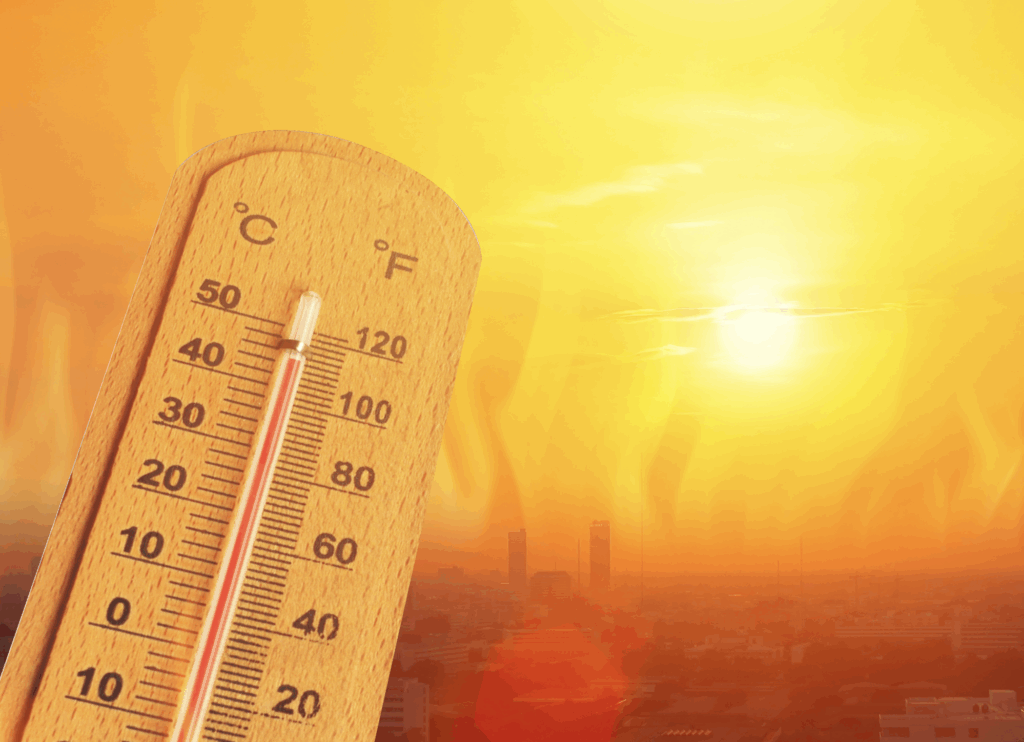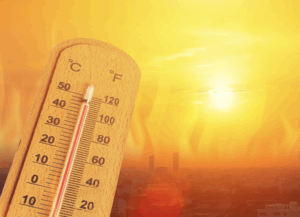Climate advisers have issued a clear warning: Britain must prepare for at least 2°C of global warming by 2050. This is the first time the UK government has been explicitly instructed to plan for a 2°C rise, exceeding the 1.5°C limit that has long been regarded as the threshold of safety. The independent Climate Change Committee (CCC) delivered this advice in October 2025, reflecting growing evidence that the world may overshoot the Paris Agreement’s 1.5°C goal well before the mid-century target. With global average temperatures already about 1.4°C above pre-industrial levels, the risk of breaching 1.5°C is alarmingly high, so the UK needs to brace for hotter conditions sooner than expected.
Government ministers were advised in a formal letter to “at a minimum, prepare the country for the weather extremes” that a 2°C global temperature rise would bring by 2050. This marks a significant shift in planning. Previous preparations assumed warming would be held to 1.5°C, but now policymakers are advised to plan for more severe outcomes. The CCC hopes that setting a 2°C preparedness target will initiate urgent action to make the nation’s infrastructure, from hospitals and schools to roads and power grids, resilient to increasing heatwaves, floods, and droughts. This really is a wake-up call that climate adaptation can no longer be an afterthought.

Importantly, preparing for 2°C does not mean giving up on the 1.5°C target. The CCC’s chair for adaptation, Baroness Julia King (Baroness Brown), emphasised that limiting warming to 1.5°C is still achievable in the long run, but it’s sensible to be planning for a 2°C scenario as a risk management strategy. In practice, this means improving both mitigation and adaptation efforts. The UK must increase its efforts to reduce greenhouse gas emissions while also protecting the country against the climate impacts that are now likely to occur in the coming decades.
Impacts of a 2°C Warmer Climate:
A 2°C rise in global temperature would have serious effects on the UK’s weather patterns and environment, and signs of strain are evident even at the current 1.4°C level. Climate scientists warn that the difference between 1.5°C and 2°C of warming is much greater than it sounds, due to nonlinear tipping point risks. At 2°C, the UK can expect a sharp uptick in extreme weather. For example, by mid-century, England could see severe heatwaves in four summers out of every five.
The summer of 2025, which was the hottest on record and contributed to hundreds of heat-related deaths in London, may become the new normal rather than an exception. Periods of drought in England are projected to double in frequency under a 2°C increase in global temperatures compared to recent decades. In southern England, the risk of wildfires could increase tenfold, a nearly unimaginable change in a country where large wildfires have been relatively rare.
Heavier rainfall and flooding are also on the horizon. With 2°C of warming, the wettest days are expected to bring 10–15% more rainfall on average. This translates to more frequent and severe floods across the UK, with some river catchments seeing peak flows surge by up to 40%. Already, communities are struggling with floods and storms that exceed the capacity of existing defences.
Without upgrades, rail lines, roads, and homes will face year-round increases in flood risk. The Climate Change Committee’s scientists stressed that the UK could look very different, very quickly under these conditions. From sweltering classrooms and hospitals to water shortages and crop failures, 2025 saw the second-worst harvest on record; the impacts touch every sector of society.
Given these projections, the CCC has urged a sweeping effort to climate-proof the nation’s buildings and infrastructure. Existing structures should be retrofitted to withstand at least 2°C of warming by 2050, rather than the previous 1.5°C benchmark. Any new construction meant to last many decades (such as major infrastructure or housing developments) should be designed with even a 4°C warming scenario in mind. While 4°C of global warming by 2100 is a worst-case scenario that everyone hopes to avoid, it cannot be ruled out if global emissions remain high, so building in a margin of safety is just common sense.
The good news is that making infrastructure more resilient is likely cheaper than the cost of climate damages in the long run. In fact, investing in resilience now, such as better insulation, flood defences, and heat-resilient designs, will save money later by avoiding costly disaster recovery and emergency costs.
Climate adaptation in the UK, however, has historically been somewhat under-resourced. The CCC’s latest advisory is a call for the government to integrate climate resilience across all departments. It’s not just an environment issue; it’s about safeguarding the economy and public well-being in a warming world. A comprehensive adaptation plan, detailing what a “well-adapted UK” should look like by mid-century, is expected from the CCC in 2026. This will likely include measures such as:
Upgrading building regulations to ensure new homes and infrastructure can handle extreme heat and floods (cooling systems, waterproofing, etc.).
Retrofitting existing homes and public buildings with insulation, ventilation, and shading to keep people safe during heatwaves and to conserve energy.
Investing in nature-based solutions, restoring wetlands, planting urban trees, which can provide cooling, flood buffering, and other ecosystem benefits.
Strengthening emergency response systems for more frequent weather disasters, ensuring communities can recover quickly.
By heeding this advice, the UK can increase its climate resilience, even as it works hard to stop further warming.

Increasing Renewable Energy to Tackle Warming:
Preparing for 2°C of warming must go hand in hand with stepping up efforts to reduce carbon emissions. The more we can cut emissions now, the better the chance of avoiding climate scenarios beyond 2°C in the latter half of the century. A cornerstone of the UK’s mitigation strategy is the transition to renewable energy. In recent years, the United Kingdom has made significant leaps in improving its power supply. New government data shows that in 2024, renewable sources (wind, solar, hydro, and biomass) generated over half, about 50.4%, of the UK’s electricity for the first time. This is a historic milestone, up from 46.5% in the previous year, indicating a rapid shift in the national energy mix toward low-carbon sources.
Wind power in particular has become the workhorse of the UK grid. In 2024, wind farms (onshore and offshore) produced roughly 29% of all electricity, nearly rivalling natural gas (around 30%) as the single largest source. The UK’s windy North Sea and coastal waters have enabled it to become a world leader in offshore wind capacity. Solar energy is also on the rise, with new solar installations contributing to record generation (about 5% of electricity in 2024). Meanwhile, coal power has been virtually eliminated; coal plants now provide close to 0% of electricity, a dramatic change from a decade ago. This clean energy progress not only cuts greenhouse gas emissions, but it also improves energy security and stabilises costs.
The government’s goal is to fully decarbonise the electricity grid by 2035, and these trends show it is on the right track. However, sustaining momentum will require supportive policies, from efficient planning approvals for wind/solar farms to modernising the grid to handle intermittent renewables. For a policy adviser, key considerations include reforming electricity markets to reward flexibility and storage, investing in grid upgrades, and encouraging domestic manufacturing of clean technology. The encouraging news is that the UK’s power sector has already halved its emissions since 1990, primarily by switching from coal to renewables, demonstrating that rapid change is possible with the right policies.
Decarbonising Heat – A Key UK Challenge:
While cleaning up electricity is well underway, decarbonising heating remains one of the toughest challenges on the path to net-zero. Heating Britain’s 28 million homes accounts for roughly 18% of the nation’s greenhouse gas emissions. Most UK homes are still warmed by fossil fuels, mainly natural gas boilers, especially during the cold winters. Transitioning this significant heating demand to sustainable methods is essential to both reduce emissions and decrease reliance on volatile fossil gas markets. It will also contribute to cleaner air, since burning gas or other fuels in millions of boilers and stoves produces indoor and outdoor air pollutants.
The government’s forthcoming Future Homes Standard aims to address this by requiring new buildings in England to be built with low-carbon heating and high energy efficiency, starting in 2025. Under proposals currently being finalised, new homes will no longer install gas boilers; instead, they will rely on solutions like electric heat pumps, heat networks, or other clean alternatives. For existing homes, retrofitting is a significant hurdle: improving insulation and transitioning millions of households to cleaner heating will require substantial investment and supportive policies, such as grants or incentives for heat pump installation and insulation upgrades.
Ecodesign Wood-Burning Stoves – Part of the Sustainable Plan:
One element in the sustainable heating toolkit or plan is the Ecodesign wood-burning stove. Wood fires have warmed homes for centuries, but traditional open fireplaces and old, inefficient stoves pollute and waste energy. In recent years, however, technology and regulations have transformed the wood-burning stove into a much cleaner appliance.
Ecodesign wood-burning stoves are a new generation of appliances engineered to drastically reduce smoke and particulate emissions, while delivering efficient heat. These stoves are the product of a European-wide program (adopted by the UK in January 2022) to lower emissions from home heating in line with DEFRA’s Clean Air Strategy. Under Ecodesign rules, any stove sold today must meet tough standards for efficiency and minimal smoke output. In fact, the stove industry, working with DEFRA, HETAS, and the Stove Industry Alliance (SIA), has developed an even higher voluntary standard called clearSkies certification for the very cleanest models.
The Charlton & Jenrick range of wood-burning stoves has been Ecodesign compliant, years before the 2022 deadline, and all are clearSkies certified.
The difference made by an Ecodesign stove is striking. Laboratory tests show that Ecodesign wood stoves emit up to 90% less particulate matter (PM) than an open hearth fire, and around 80% less PM than a typical 10-year-old wood-burning stove. In practical terms, upgrading from an old stove or open fire to an Ecodesign model can eliminate the vast majority of the soot, smoke, and fine particles that would otherwise go up your chimney (and into the air). Modern stoves are designed for more complete combustion, featuring high temperatures, improved airflow, and baffle systems that burn the wood more fully, resulting in fewer unburnt particulates.
Below is an example of an Ecodesign wood-burning stove. Our Purevision BPV5 Slimline, shown on a Countryman Stand.

Policy-wise, the role of wood stoves in new construction has been a point of debate. As mentioned, the Future Homes Standard consultation initially raised questions about whether any combustion appliances should be allowed in ultra-low-energy new homes. Following input from the industry and a review of the evidence, the government confirmed that Ecodesign-compliant wood stoves will be permitted as a secondary heating option in new builds. This means a new house could have, for example, a primary heating system, such as a heat pump, for everyday use, plus a wood-burning stove for supplementary heat or ambience.
The rationale is that a stove can serve as a backup on very cold days or during power outages, and if it’s a clean-burning model using renewable fuel, it can fit into a low-carbon home design. The Stove Industry Alliance welcomed this decision, seeing it as validation that modern stoves have a place in our future homes, as long as air quality rules are met.
For sustainable homebuilders, this offers flexibility to cater to consumer preferences; many homebuyers do enjoy a fireplace or stove for cosy warmth without compromising on the overall environmental performance of the house.
Policy and Industry Perspectives on a Low-Carbon Future:
The growth of climate adaptation needs and clean energy goals means policymakers must coordinate across many areas. A government preparing for 2°C warming will need to incorporate climate resilience into new policies, from how we build homes to how we generate energy, to how we heat those homes and transport people. For a policy advisor, the recent CCC warning reinforces the importance of long-term thinking and preventative action. Funding adaptation, such as stronger flood defences or hospital cooling systems, can save lives and money in the long run. Likewise, maintaining momentum on emission cuts, through renewables, energy efficiency, and possibly emerging technologies like carbon capture, is vital to prevent even more drastic climate outcomes beyond 2050.
On the energy front, advisors are likely to push for continued support of renewable energy deployment (offshore wind auctions, solar incentives, grid storage solutions) as well as development of energy markets to handle a high-renewables grid. There is also a need for policies that encourage energy conservation and smarter usage, which can reduce strain during extreme weather events. For example, better-insulated homes not only cut heating emissions but also stay cooler during heatwaves, protecting vulnerable residents.

Regarding home heating, government schemes to help households switch to sustainable heating are vital. The UK has already launched programs, such as the Boiler Upgrade Scheme, to subsidise heat pumps, as well as local initiatives to pilot heat networks. Expanding and publicising these will increase uptake. At the same time, ensuring just transitions is key: not everyone can afford a new heat pump or electric retrofit upfront, so grants or financing assistance, especially for low-income and rural communities, will be needed to avoid leaving anyone behind.
Policy advisors might also consider regulatory measures, for instance, setting dates after which old, inefficient boilers or polluting stoves can no longer be used, paired with support to replace them with cleaner alternatives.
Conclusion:
The warning that the UK must prepare for 2°C of global warming by 2050 is a reminder of the challenges ahead. By planning ahead, we can protect our communities from the worst impacts of extreme weather while transforming energy and heating systems for a sustainable future. The solutions are at hand: from the wide deployment of renewable energy that is already underway, to the changing way we heat our homes. The road to net-zero and climate resilience will impact everyone, including the general public, policymakers, businesses, and builders, and will require considerable collaboration and forward-thinking.
Preparing for 2°C of global warming is about protecting essential aspects of life in the UK, our homes, health, and natural environment. Taking action now will help the country manage future impacts such as storms and heatwaves, while supporting a transition to renewable energy and sustainable living. With substantial planning, the UK can build resilience and ensure that by 2050, it remains secure, energy-efficient, and powered by clean energy.











